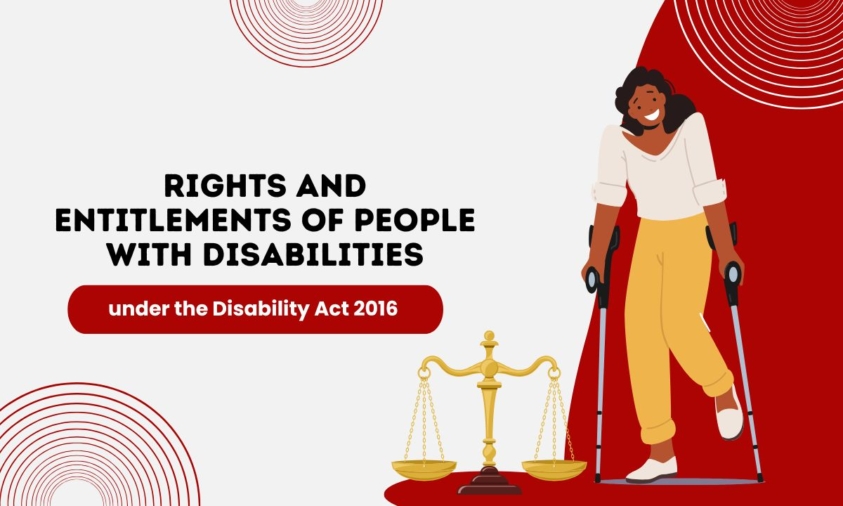Introduction: The Disability Act 2016 is a crucial legislation that aims to protect and promote the rights of people with disabilities in India. The Act recognizes the inherent dignity and equal worth of every individual, ensuring that persons with disabilities enjoy the right to equality, non-discrimination, and a life with dignity. This blog will explore the key rights and entitlements provided to people with disabilities under the Disability Act 2016.
- Equality and Non-discrimination (Section 3): The Disability Act 2016 under section 3(1) states that (“The appropriate Government shall ensure that the persons with disabilities enjoy the right to equality, life with dignity and respect for his or her integrity equally with others”).The appropriate government is mandated to create an inclusive environment that enables the utilization of the capacities of persons with disabilities. Discrimination based on disability is prohibited, except when it can be justified as a proportionate means of achieving a legitimate aim. Personal liberty cannot be deprived solely on the grounds of disability. Additionally, reasonable accommodations must be provided to ensure equal participation and access for persons with disabilities.
- Community Life (Section 5): Persons with disabilities have the right to live in the community, free from any obligation to reside in a particular living arrangement. The Act mandates the appropriate government to provide a range of support services, including personal assistance, which enables individuals to live with dignity, considering factors such as age and gender.
- Protection from Cruelty, Abuse, and Violence (Section 6 and 7): The Act ensures measures are in place to protect persons with disabilities from torture, cruel, inhuman, or degrading treatment. No person with a disability can be subjected to any research without their free and informed consent. The Act also establishes provisions to prevent and address abuse, violence, and exploitation against persons with disabilities, including the creation of awareness, legal remedies, and rehabilitation measures.
- Protection and Safety (Section 8): Persons with disabilities are entitled to equal protection and safety during situations of risk, armed conflict, humanitarian emergencies, and natural disasters. The Act directs the National and State Disaster Management Authorities to include persons with disabilities in their disaster management activities, ensuring their safety and protection. District Disaster Management Authorities maintain records of persons with disabilities in the district to enhance disaster preparedness.
- Access to Justice (Section 12): The Act guarantees that persons with disabilities have the right to access courts, tribunals, and other judicial or quasi-judicial bodies without discrimination. Suitable support measures are to be provided to enable individuals to exercise their legal rights. The National and State Legal Services Authorities must ensure that persons with disabilities have equal access to legal schemes, programs, facilities, and services. Accessibility requirements, such as accessible formats and communication means, are also addressed.
- Legal Capacity and Guardianship (Section13 and 14): Persons with disabilities have the right to own and inherit property, control their financial affairs, and access financial credit. They enjoy legal capacity on an equal basis with others, and their autonomy and privacy should be respected. The Act introduces limited guardianship, where a person with a disability may receive support for legally binding decisions, ensuring the person’s will is considered. Appellate authorities are established to address grievances related to the appointment of legal guardians.
- Women and Children with Disabilities (Section 4): The Act recognizes the specific rights of women and children with disabilities as well. The appropriate government and local authorities are obligated to ensure that women and children with disabilities enjoy their rights equally with others. It includes measures to safeguard their rights, provide appropriate support, and enable their active participation in decisions affecting them.
Conclusion
The Disability Act of 2016 stands as a significant milestone in the pursuit of an inclusive society that upholds the rights and entitlements of individuals with disabilities. By ensuring equality, non-discrimination, accessibility, education, employment, social security, and legal aid, the act seeks to create an enabling environment for persons with disabilities to fully participate in all aspects of life. It is incumbent upon governments, organizations, and society as a whole to implement and uphold these rights, promoting inclusivity and embracing the invaluable contributions of individuals with disabilities. Let us strive together to build a world where everyone, regardless of ability, can thrive and reach their full potential.


 Cart is empty
Cart is empty 
